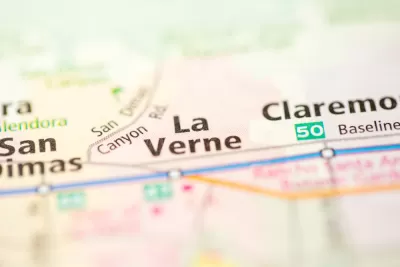La Verne is the first city in Los Angeles County, and one of the first in the state, to implement an Enhanced Infrastructure Financing District, designed to generate a source of funding to replace the loss of redevelopment funds during the recession.

Joe Mathews reports from La Verne, a small city of about 32,000 residents located on the eastern edge of Los Angeles County that has taken on a massive experiment in the state of California.
That’s because this city — for its own reasons — has formed one of California’s first EIFDs. The acronym stands for enhanced infrastructure financing district, a new government entity that the Legislature has championed for addressing California’s massive housing shortage and infrastructure deficit.
But EIFDs are unproven, and only a handful of California places have established them. In fact, EIFDs are a much weaker tool than the redevelopment agencies that localities relied upon for major projects before 2012, when redevelopment was eliminated because the agencies grabbed revenues that otherwise would have gone to schools.
EIFDs work similarly — designate a certain area for improvement and then capture the increased tax receipts — but state lawmakers put limits on their ability to take revenues from other taxing entities.
La Verne is deploying the EIFD in anticipation of a forthcoming light rail station connecting to the Los Angeles County Metropolitan Transportation Authority's Gold Line, expected to open in 2026. La Verne has a bustling "Old Town" district, is home to the University of La Verne, and is located next door to the Fairplex facility which hosts the county fair and other large events throughout the year. La Verne was also hit hard by the foreclosure crisis of the Great Recession and subject to affordability concerns like most California communities in large metropolitan areas in 2019.
According to Mathews, other parts of the state are eager to see the results of La Verne's experimentation to consider EIFDs connected to large projects like the restoration of the Los Angeles River or the extension of BART through San Jose.
Planetizen blogger Linda Day wrote a detailed explanation of EIFDs back in 2016.
FULL STORY: How one small city could show way for California housing challenge

Trump Administration Could Effectively End Housing Voucher Program
Federal officials are eyeing major cuts to the Section 8 program that helps millions of low-income households pay rent.

Planetizen Federal Action Tracker
A weekly monitor of how Trump’s orders and actions are impacting planners and planning in America.

Ken Jennings Launches Transit Web Series
The Jeopardy champ wants you to ride public transit.

Crime Continues to Drop on Philly, San Francisco Transit Systems
SEPTA and BART both saw significant declines in violent crime in the first quarter of 2025.

How South LA Green Spaces Power Community Health and Hope
Green spaces like South L.A. Wetlands Park are helping South Los Angeles residents promote healthy lifestyles, build community, and advocate for improvements that reflect local needs in historically underserved neighborhoods.

Sacramento Plans ‘Quick-Build’ Road Safety Projects
The city wants to accelerate small-scale safety improvements that use low-cost equipment to make an impact at dangerous intersections.
Urban Design for Planners 1: Software Tools
This six-course series explores essential urban design concepts using open source software and equips planners with the tools they need to participate fully in the urban design process.
Planning for Universal Design
Learn the tools for implementing Universal Design in planning regulations.
Heyer Gruel & Associates PA
Ada County Highway District
Institute for Housing and Urban Development Studies (IHS)
City of Grandview
Harvard GSD Executive Education
Toledo-Lucas County Plan Commissions
Salt Lake City
NYU Wagner Graduate School of Public Service





























